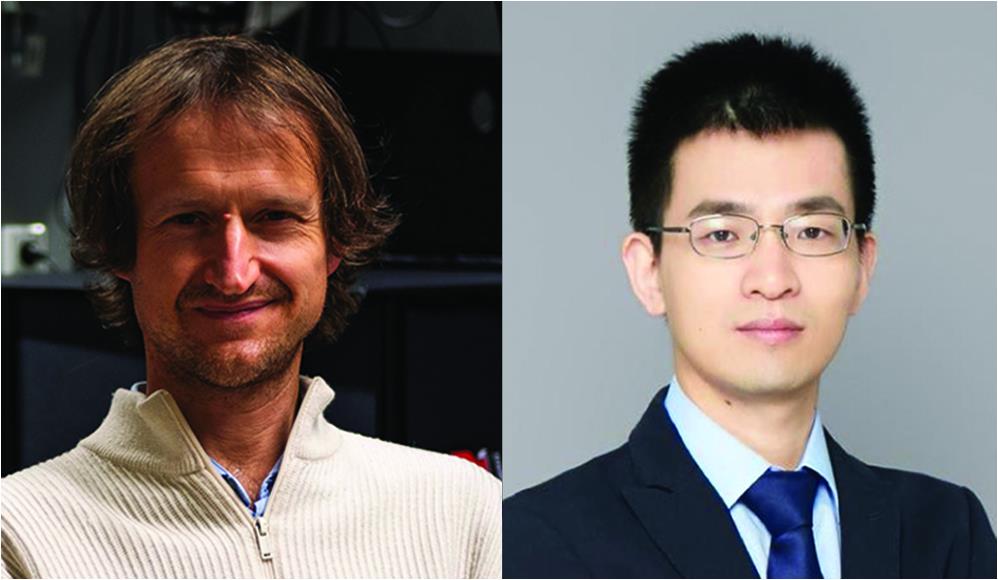Guest editors Chao-Yang Lu (Univ. of Science and Technology of China) and Mario Agio (Univ. of Siegen and CNR-INO) present an Advanced Photonics collection spotlighting quantum science and technologies.
- Advanced Photonics
- Vol. 3, Issue 6, 060101 (2021)
Abstract
![]()
Figure 1.Mario Agio (Univ. of Siegen & CNR-INO; photo credit, S. Nimmrichter) (left); Chao-Yang Lu (USTC) (right).
Quantum science and technology is currently one of the most exciting frontiers in research and innovation. Tremendous effort is being devoted to pushing fundamental science into technology, with support from large, coordinated programs that involve academia, research centers, and industry worldwide. Throughout more than half a century of research, driven by curiosities in fundamental quantum physics, experiments in quantum optics, together with atomic, molecular, and optical physics, have laid the foundation for the development of a second quantum revolution, where fundamental concepts like quantum superposition, entanglement, and indistinguishability are now routinely exploited to realize quantum computing components, secure communications, and quantum-enhanced sensors with unprecedented performances. However, to become practically useful technologies, these ambitious goals still require a great deal of basic research effort, which must be combined with engineering and other disciplines to succeed. This exciting and intriguing perspective can be clearly witnessed in the recent interview of Prof. Xiaosong Ma with Sir Peter Knight in this issue of Advanced Photonics.
To spotlight advances in quantum science and technologies, we have invited review articles and original research contributions on this topic, gathered here in a collection. The collection is not intended to be a comprehensive account of photonic advances in quantum, but rather aims at emphasizing the important role of photonics in enabling the development of quantum technologies. We present two review articles and five original contributions from authoritative scientists in the field. S. Castelletto and A. Boretti review the emerging use of color centers in wide-band gap materials for sub-diffraction imaging, pointing out the widening of activities based on solid-state quantum emitters, originally addressed in solid-state quantum optics. Wang et al. discuss the impressive advancements on the implementation of quantum entanglement on a chip, based on progress in different integrated photonics platforms. The original research papers demonstrate how advanced photonics, such as the use of metasurfaces, integrated optics, and quantum dots, represents a unique resource for quantum technologies. They also point out that there is still much room, and need, for improvement in quantum-optical techniques and protocols.
We hope that readers, both established and early career researchers, will find this collection inspiring and, years later, will remember the onset of quantum technologies like Sir Peter Knight did for the onset of quantum optics: “I found it really fascinating!”
Sign up for Advanced Photonics TOC. Get the latest issue of Advanced Photonics delivered right to you!Sign up now
For convenience, the collection of articles is listed here:
“From fundamental quantum optics to quantum information technology: the personal journey of Sir Peter Knight” by Xiaosong Ma
“Color centers in wide-bandgap semiconductors for subdiffraction imaging: a review” by Stefania Castelletto and Alberto Boretti
“Quantum entanglement on photonic chips: a review” by Xiaojiong Chen, Zhaorong Fu, Qihuang Gong, and Jianwei Wang
“Heterogeneously integrated, superconducting silicon-photonic platform for measurement-device-independent quantum key distribution” by Xiaodong Zheng, Peiyu Zhang, Renyou Ge, Liangliang Lu, Guanglong He, Qi Chen, Fangchao Qu, Labao Zhang, Xinlun Cai, Yanqing Lu, Shining Zhu, Peiheng Wu, and Xiao-Song Ma
“Direct characterization of coherence of quantum detectors by sequential measurements” by Liang Xu, Huichao Xu, Jie Xie, Hui Li, Lin Zhou, Feixiang Xu, and Lijian Zhang
“Enhanced generation of non-degenerate photon-pairs in nonlinear metasurfaces” by Matthew Parry, Andrea Mazzanti, Alexander Poddubny, G. D. Valle, Dragomir Neshev, and Andrey A. Sukhorukov
“Entanglement-based quantum key distribution with a blinking-free quantum dot operated at a temperature up to 20K” by Christian Schimpf, Santanu Manna, Saimon F. Covre da Silva, Maximilian Aignera, and Armando Rastelli
“Dynamical learning of a photonics quantum state-engineering process” by Alessia Suprano, Danilo Zia, Emanuele Polino, Tiara Giordani, Luca Innocenti, Alessandro Ferraro, Mauro Paternostro, Nicolò Spagnolo, and Fabio Scarrino
Mario Agio studied physics at the University of Pavia and Iowa State University with Prof. Lucio Claudio Andreani and Prof. Costas M. Soukoulis, respectively. He graduated in 2003 with a thesis on the fundamentals and applications of semiconductor-based photonic crystals. In 2004 he joined the Nano-Optics Group of Prof. Vahid Sandoghdar at ETH Zurich, where his research interests have broadened to single-molecule spectroscopy, near-field optics, and quantum optics. He was awarded the Italian Physical Society prize for graduate students (2002) and the Latsis Prize of ETH Zurich (2010) for his accomplishments in nano-optics. In 2011 he received the habilitation in physical chemistry from ETH Zurich. From 2012 to 2015 he was with the National Institute of Optics (CNR-INO) and the European Laboratory for Nonlinear Spectroscopy (LENS) in Florence. Since April 2015 he is responsible for the Laboratory of Nano-Optics at the University of Siegen, Germany, and since April 2021 he also holds a part-time appointment with CNR-INO.
Chao-Yang Lu obtained his PhD in physics from the University of Cambridge in 2011. He is currently a professor of physics at USTC. His research interests include quantum computation, quantum photonics, multiparticle entanglement, quantum teleportation, superconducting circuits, and atomic arrays. His work on quantum teleportation was selected by Physics World as “Breakthrough of the Year 2015." He has been recognized as one of Nature’s top ten “science stars of China” (2016), elected an OSA fellow (2017), and awarded numerous prizes, including the Fresnel Prize from the European Physical Society (2017), AAAS Newcomb Cleveland Prize (2018), Huangkun Prize from Chinese Physical Society (2019), Nishina Asian Award (2019), Xplorer Prize (2019), IUPAP-ICO Young Scientist Prize in Optics (2019), OSA Adolph Lomb Medal (2020), and Rolf Landauer and Charles H. Bennett Award in Quantum Computing (2021).
References

Set citation alerts for the article
Please enter your email address



